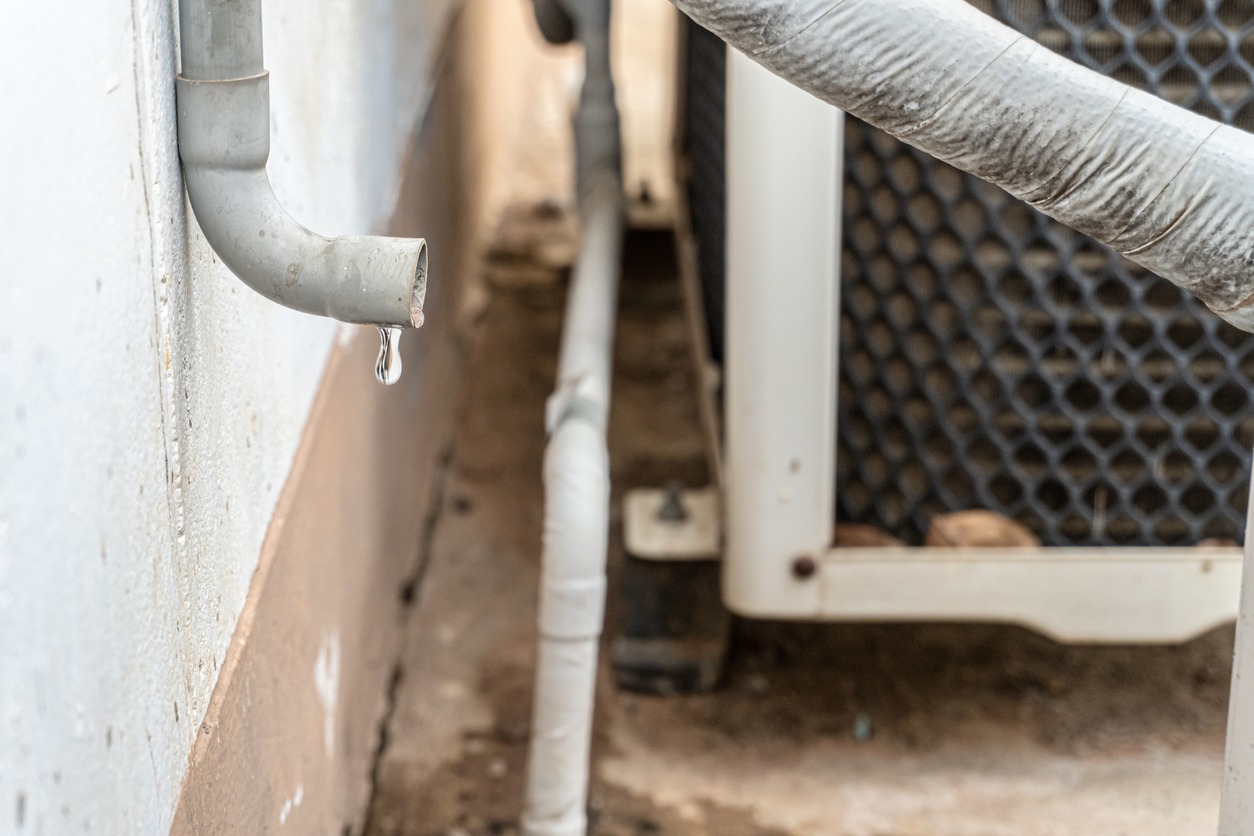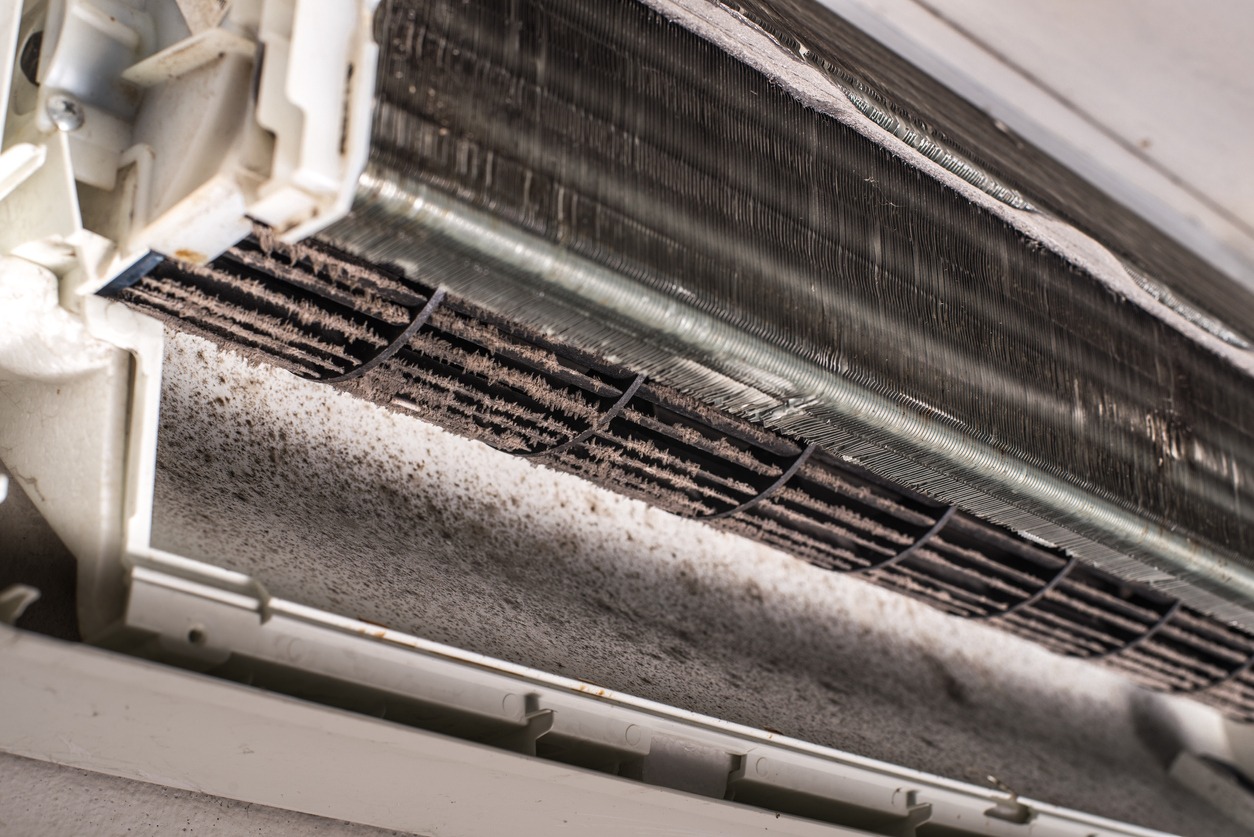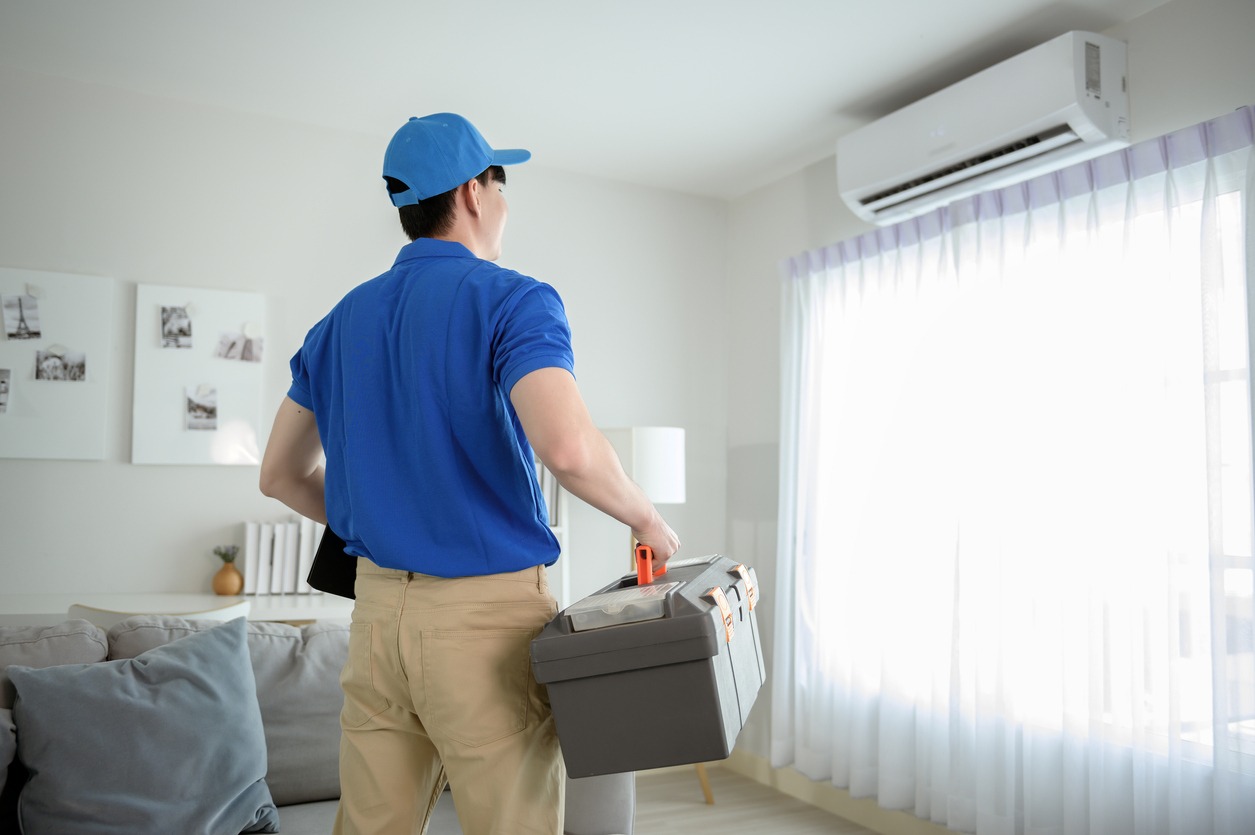Your air conditioner’s drain line plays a critical role in the system’s overall performance, quietly whisking away condensation and moisture that accumulates during the cooling process. However, when this essential component becomes clogged, it can lead to a host of problems that not only affect your comfort but can also cause significant damage to your property. Homeowners and property managers alike should be vigilant for the telltale signs of a blockage to prevent costly repairs and maintain an efficient, healthy living environment. This article will guide you through the symptoms of a clogged AC drain line, explore the underlying causes, and provide actionable advice on maintenance and prevention, ensuring that you can keep your cool when the temperatures rise.
Recognizing a Clogged AC Drain Line: Key Symptoms
Awareness of the telltale signs that your AC drain line is obstructed can be the difference between a quick fix and extensive, costly repairs. Vigilance in detecting these indicators is essential for maintaining the health of your home’s cooling system.
Visible Water Leaks and Pooled Water
When water begins to gather around your air conditioning system, it’s often a red flag signaling a blockage in the drain line. This excess condensate, which should normally exit through the drainage system, is instead forced to spill over the confines of the drain pan. If your AC unit is installed above the ground level, you may also discover leaks manifesting in the ceilings or walls, which is a direct consequence of the clog. These accumulations are more than mere annoyances; they present a real threat of damage to your home’s structure, potentially affecting floors, walls, and the AC equipment itself. Moreover, the intrusion of water into electrical areas and insulation can lead to expensive repair needs.
Signs such as water stains or corrosion near the drain line or pan suggest an ongoing issue that requires immediate action to prevent further damage, as previously mentioned in relation to humidity control and mold risks. By conducting routine checks for abnormal moisture around both indoor and outdoor AC units, you can identify early signs of trouble and address them before they worsen. Should you encounter water leaks or pooling, it’s imperative to promptly clear the clog in the drain line to avoid additional complications.
Foul Smells and Mold Growth
The emergence of musty odors in your home could be a telltale sign that your AC’s drain line is obstructed. This blockage can cause water to stagnate, creating a perfect habitat for mold and mildew to flourish. These organisms thrive in moist environments and can start to colonize the drain line or drain pan, which are typically out of sight. If a persistent, moldy aroma becomes noticeable, especially when the air conditioning is active, it’s a strong indicator that mold has taken hold somewhere within the system.
While mold’s distinct smell is a clear sign, its impact on indoor air quality is a silent threat. Exposure to mold spores can exacerbate allergies and respiratory conditions, emphasizing the importance of addressing the issue swiftly. To prevent these complications, it’s essential to keep the drain pan and line clear, a topic that will be explored further in the maintenance section.
If these odors are not resolved quickly, they can lead to more serious health risks and may necessitate the intervention of mold remediation specialists. Therefore, it’s crucial to take immediate action upon detecting these smells to ensure the health and safety of your indoor environment.
System Efficiency and Humidity Issues
An obstructed drain line in your AC system can have far-reaching effects on its efficiency. Moisture that would typically be channeled away can accumulate, compelling your air conditioner to exert more effort to achieve the desired climate control. This additional strain not only diminishes the unit’s cooling capabilities but can also lead to a noticeable uptick in energy consumption, reflected in your utility bills.
Excessive indoor humidity is another consequence of a clogged drain line. This can manifest as a sticky, heavy atmosphere within your home, making the environment feel less comfortable. Moreover, this dampness is conducive to the proliferation of mold and mildew, further compounding the issues associated with high humidity levels.
Awareness of these symptoms is crucial, as they can signal a compromised AC system that may be struggling due to a clogged drain line. Addressing this problem promptly can restore both your comfort and the unit’s performance, safeguarding the longevity of your air conditioning investment. If you notice persistent humidity despite your AC running normally, it’s time to investigate the drain line as a potential source of the problem.
Understanding the Causes of Drain Line Clogs
A clogged AC drain line can be a source of frustration, but grasping the root causes can pave the way for effective prevention and resolution. Various factors contribute to these blockages, each with its own solution.
Accumulation of Debris: The drain line can become a repository for an assortment of debris, including leaves, dirt, and even small insects. This detritus can congregate over time, leading to a stubborn blockage. Ensuring that air filters are replaced regularly can mitigate the influx of such particles into the system.
Growth of Algae and Mold: The moist and shaded environment of the drain line is an ideal breeding ground for algae and mold. These organisms can multiply rapidly, creating a viscous obstruction that is challenging to remove without specialized equipment.
Formation of Slime and Sediment: In locales with mineral-rich water, deposits can form within the drain lines, narrowing the passage and eventually causing clogs. Similarly, slime resulting from bacterial growth can contribute to this problem.
Corrosion and Rust: Over time, the metal components of AC drain pans and lines may succumb to corrosion. Flakes of rust can then dislodge and form a barrier to water flow.
Installation Issues: A drain line that isn’t angled correctly can lead to water pooling, which heightens the risk of blockages. This issue often stems from subpar installation practices.
Armed with the knowledge of these common culprits, you can take proactive steps to keep your AC system running smoothly, as we will explore in upcoming sections.
Debris and Mold: Common Culprits
When it comes to clogged AC drain lines, debris and mold are often the primary antagonists. Their interference with the system’s operations can be both insidious and gradual.
Debris such as pollen, dust, and pet dander can build up, starting at the air filters and potentially extending into the drain line. The risk of clogging increases during periods of heavy use or in environments with a high dust presence, underscoring the necessity of frequent filter replacements.
Mold, on the other hand, finds a hospitable environment in the drain line’s inherent moisture and lack of light. It can cling to the walls of the drain line, forming a dense mat that impedes the flow of water.
The obstruction caused by these elements does more than just clog the line; it can also compromise the air quality and overall efficiency of your AC unit. Regular maintenance, which includes thorough cleaning and inspections, is crucial to prevent these common issues from disrupting your system’s performance.
Maintenance and Prevention of AC Drain Line Clogs
To safeguard your air conditioning system against the disruption of clogs, a blend of regular upkeep and preemptive actions is essential. Homeowners can sidestep the headaches associated with blockages by committing to a structured maintenance routine.
Consistent Cleanliness: Intermittently, the drain line requires a thorough flush with a concoction of either vinegar or bleach diluted in water. This practice, executed by introducing the mixture into the drain line through the service port, is pivotal in eradicating mold or algae and clearing away accumulated debris.
Professional Oversight: Entrusting a skilled technician to conduct an annual review of your system can catch burgeoning issues in their infancy. Equipped with specialized tools and knowledge, these experts can perform an exhaustive cleaning and evaluation of the HVAC system, paying close attention to the evaporator coils and drain pan.
Frequent Filter Replacement: Adhering to the manufacturer’s guidelines or the advice of HVAC experts, replacing air filters at appropriate intervals can significantly cut down on the detritus that might enter the drain line, thereby diminishing the risk of blockages.
Accuracy in Installation: It’s crucial to verify that all components of the AC system, particularly the drain line, are installed with precision. A drain line that’s not correctly positioned can lead to water stagnation and subsequent clogging.
Algae Prevention: Introducing anti-algae tablets or strips into the drain pan can stave off the proliferation of algae and mold. These products dissolve gradually, offering a sustained defense against biological contaminants.
Embracing these strategies for maintenance and prevention not only prolongs the operational lifespan of your air conditioning unit but also upholds air quality, system efficiency, and circumvents the expenses and inconveniences of clogged drain lines.
Proactive Cleaning and Inspections
A vigilant approach to cleaning and regular inspections stands as the bedrock for keeping your AC drain line free-flowing. By instituting a routine cleaning regimen, homeowners can tackle the precursors of clogs, such as mold, algae, and assorted debris. A straightforward and beneficial practice involves flushing the drain line with a blend of water and vinegar or a gentle detergent every several months, which combats bacterial or mold growth and deters the accumulation of clog-inducing substances.
The role of professional evaluations in this preventive strategy cannot be overstated. While homeowners can manage routine upkeep, certified technicians bring a level of thoroughness that only comes with specialized training. They can conduct a holistic assessment of the system, ensuring that each component, especially the drainage apparatus, is in optimal condition and administer a more intensive cleaning when necessary.
These professionals are also a valuable resource for tailored maintenance recommendations, considering factors such as the age of your system, usage patterns, and the unique environmental conditions of your residence. They may suggest more frequent cleanings or additional preventive measures to ensure peak performance.
By proactively engaging in regular cleanings and enlisting the expertise of professionals for inspections, you can significantly mitigate the risk of clogs and guarantee the enduring efficacy of your air conditioning system.
Implementing Overflow Protection Measures
To safeguard your home from the havoc a clogged AC drain line can wreak, it’s prudent to put into place overflow protection strategies. These tactics serve as an early warning system, signaling issues before they escalate, or they can actively halt overflow in its tracks.
Float Switch Installation: Consider equipping your drain pan with a float switch. This nifty gadget triggers when water levels surge to a height that suggests the drain line is overwhelmed, often a sign of a blockage. Once activated, it powers down the air conditioner, halting condensate production and circumventing potential overflow.
Secondary Drain Lines: For an added layer of security, some systems come with an auxiliary drain line. This secondary pathway offers condensate an alternate escape route if the primary one is obstructed, reducing the risk of overflow.
Drain Pan Sensors: Technologically advanced AC units may support the integration of sensors that detect excess water in the drain pan. These can be synced with a smart home system or an alarm, providing immediate alerts when potential overflows are detected, prompting swift action.
Visual Inspections: Beyond these automated defenses, it’s beneficial to visually inspect the condensate drain pan periodically. This simple step during regular maintenance checks can reveal water accumulation, potentially flagging a nascent drain line issue.
By adopting these protective measures, you can fortify your AC system against the disruptions caused by drain line blockages. This is especially crucial in scenarios where the AC unit is situated in an attic or above living spaces, as any overflow could result in significant damage and financial loss.
When to Call a Professional for a Clogged AC Drain Line
While proactive homeowners can handle basic maintenance, certain scenarios necessitate the expertise of a professional to address a clogged AC drain line.
Persistent Clogs: Should you encounter clogs with alarming regularity, despite diligent maintenance, it’s time to consult a professional. They possess the skills to unearth the problem’s core and provide a durable remedy.
Significant Water Damage: Upon discovering substantial water damage linked to your AC unit, professional intervention is critical. Experts can manage the issue adeptly and evaluate any potential harm to your home’s integrity or the AC system itself.
Specialized Equipment: HVAC professionals come equipped with advanced tools and cleaning agents, often beyond the reach of homeowners. These resources are essential for thoroughly resolving stubborn clogs.
Complex HVAC Systems: If your AC system is particularly intricate, deciphering its nuances might require professional insight. Mishandling could exacerbate the problem, leading to additional damage and expenses.
Health Risks: For those with health concerns or sensitivities to mold and bacteria, a professional’s thorough cleaning ensures harmful contaminants are eradicated safely and effectively.
In these instances, the knowledge and tools a professional HVAC technician provides are indispensable. They guarantee that your system is restored promptly and reduce the likelihood of recurring issues. Prompt professional care can be a wise investment, potentially saving on future repairs and prolonging your air conditioner’s lifespan.
Evaluating the Severity and Recurrence of Clogs
Assessing the gravity of a blockage in your air conditioner’s drain line is a pivotal step in determining the necessity for expert intervention. While minor obstructions might succumb to simple home-based tactics—like employing a wet-dry vacuum on the drain line’s exterior or channeling a cleaning solution through the system—more stubborn clogs require a different approach.
The impact of a clog on your AC’s functionality, along with the speed at which issues such as water accumulation or musty smells resurface after a cleaning, can be indicative of the clog’s severity. Should you find your system shutting down, lagging in response, or leaking water soon after a routine cleanse, these are red flags signaling a more serious blockage.
Furthermore, the frequency with which clogs reappear offers valuable insights. A blockage that makes an unwelcome return shortly after being cleared, particularly if it occurs multiple times within a single season, points to an underlying problem that simple fixes may not resolve. This could range from an internal structural issue to the necessity for a more comprehensive professional cleaning.
In such cases, seeking the expertise of a professional is a prudent choice. They possess the tools and know-how to perform an in-depth assessment and address severe or recurring clogs effectively, safeguarding your system from potential damage. Persisting with home remedies in light of significant or repeated blockages could exacerbate the problem, potentially leading to extensive water damage or compromising the integrity of your AC unit.
Understanding the Limitations of DIY
Embracing the DIY spirit for home maintenance can be cost-effective and gratifying, yet it’s essential to recognize when such efforts might fall short, especially with intricate systems like your air conditioning. Acknowledging these boundaries helps protect your system and ensures your safety.
DIY approaches often scratch only the surface of the problem. Homeowners may manage to clear out visible blockages and rinse the drain line, but deeper obstructions and concealed issues often evade such simple methods due to the lack of specialized tools.
Additionally, the risk of inadvertently damaging sensitive AC components is heightened during DIY endeavors. The system’s intricate parts and the handling of refrigerants demand a level of expertise and caution that goes beyond the average homeowner’s skill set.
The diagnostic equipment necessary to thoroughly investigate and resolve issues within an AC unit is typically beyond the reach of most homeowners. Without these tools, it’s impossible to guarantee that all underlying causes of a clogged drain line have been effectively addressed.
It’s also vital to consider the health implications when dealing with mold and bacteria that may have proliferated because of a clog. Improper handling of these contaminants can pose serious health risks, especially for individuals with allergies or respiratory issues.
Lastly, warranty and insurance considerations cannot be overlooked. Tampering with your AC system without professional credentials may void warranties, and should water damage result from an ill-advised DIY fix, insurance might not cover the repairs if they weren’t performed by a licensed technician.
While routine, straightforward maintenance tasks are well-suited for DIY, it’s best to leave more complex challenges, like recurring or severe clogs, to the professionals. They bring the necessary expertise, equipment, and qualifications to the table, ensuring the job is done safely and effectively.
Useful FAQs for Troubleshooting Clogged Air Conditioner Drain Lines
What are the common indicators of a clogged air conditioner drain line?
Common indicators include water leaks around the air conditioning unit, a musty odor, the presence of mold in or around the unit, and declining efficiency or performance of the air conditioning system.
Can a constantly running air conditioner suggest a clogged drain line?
Yes, a constantly running air conditioner may indicate a clogged drain line. The system remains operational, trying to reach the set temperature, but the clog could be hindering performance, causing the unit to run continuously.
Does an unexpected increase in humidity levels hint at a clogged drain line?
An unexpected increase in humidity levels could suggest a clogged air conditioner drain line. The unit’s dehumidifying processes could be hampered from properly releasing moisture due to the obstruction.
How does a musty smell relate to a clogged air conditioner drain line?
A musty smell often suggests a clogged drain line. The obstruction can cause accumulated water that leads to mold and mildew growth, resulting in a musty or damp smell in the air.
Can mold growth be a sign of a clogged air conditioner drain line?
Yes, mold growth can be a sign of a clogged air conditioner drain line. With water unable to drain, conditions become perfect for mold growth. Regular inspection helps in early detection of this issue.
What can be observed outside the unit to identify a clogged air conditioner drain line?
If the drain line is clogged, a keen observation outside the unit would reveal stagnant water pooling. This water is unable to drain off, indicating a potential obstruction in the line.




